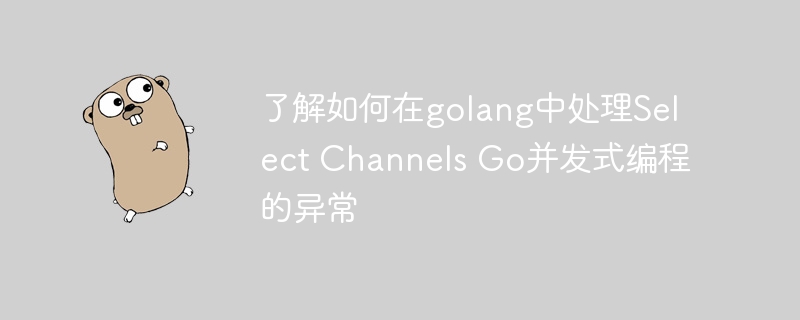Home >Backend Development >Golang >Learn how to handle exceptions in Select Channels Go concurrent programming in golang
Learn how to handle exceptions in Select Channels Go concurrent programming in golang
- WBOYWBOYWBOYWBOYWBOYWBOYWBOYWBOYWBOYWBOYWBOYWBOYWBOriginal
- 2023-09-27 16:15:571364browse

Learn how to handle exceptions in Select Channels Go concurrent programming in golang
In the Go language, concurrent programming can be easily performed using goroutine and channel. However, in actual development, we need to pay attention to handling exceptions and error conditions that may occur. This article will introduce how to use select and channel in Go language to handle exceptions in concurrent programming, and provide code examples.
In the Go language, you can use select to monitor messages from multiple channels at the same time and handle them differently according to different situations. In concurrent programming, we often need to coordinate and communicate between multiple channels. When multiple channels are ready, the select statement will randomly select a case for execution. When no channel is ready, the select statement will enter the blocking state until a channel is ready.
However, in concurrent programming, sometimes we need to handle some abnormal situations, such as timeout, channel closing, etc. Here is a sample code for handling exceptions:
package main
import (
"fmt"
"time"
)
func main() {
ch1 := make(chan int)
ch2 := make(chan int)
go func() {
time.Sleep(2 * time.Second)
ch1 <- 1
}()
go func() {
time.Sleep(3 * time.Second)
close(ch2)
}()
select {
case <-ch1:
fmt.Println("Received from ch1")
case <-ch2:
fmt.Println("Channel ch2 closed")
case <-time.After(1 * time.Second):
fmt.Println("Timeout")
}
} In the above code, we have created two channels ch1 and ch2. In the goroutine, ch1 will send a message after 2 seconds, and ch2 will close after 3 seconds. In the select statement, we handle the following situations respectively:
- When ch1 is ready, a message will be received from ch1 and "Received from ch1" will be printed.
- When ch2 is closed, a zero value message will be received from ch2 and "Channel ch2 closed" will be printed.
- After waiting for 1 second, if the select statement still does not have any channel ready, a timeout will be triggered and "Timeout" will be printed.
In actual development, we can handle exceptions as needed. For example, we can use channels to notify goroutine to exit, or use default cases in select statements to handle some default situations. The following is a sample code for handling exit signals:
package main
import (
"fmt"
"os"
"os/signal"
)
func main() {
ch := make(chan os.Signal)
signal.Notify(ch, os.Interrupt)
select {
case sig := <-ch:
fmt.Println("Received signal:", sig)
// 执行一些清理工作
os.Exit(1)
default:
// 正常处理逻辑
}
} In the above code, we create a channel ch and use the signal.Notify function to operate The system's interrupt signal is sent to this channel. In the select statement, we wait to receive the interrupt signal from the operating system. Once the interrupt signal is received, some cleanup work will be performed and the program will exit.
Summary:
In the Go language, concurrent programming can be easily performed using goroutine and channel. However, when dealing with exceptions in concurrent programming, we need to pay attention to using select and channels for coordination and communication. By rationally using select statements and channels, we can handle abnormal situations such as timeouts and channel closures, and handle them accordingly.
The above is the detailed content of Learn how to handle exceptions in Select Channels Go concurrent programming in golang. For more information, please follow other related articles on the PHP Chinese website!
Related articles
See more- Detailed explanation of bootstrap editable drop-down box jquery.editable-select example
- How to use querySelector method
- What is php exception handling method
- Detailed introduction to exception types and exception handling in java
- What is exception handling in PHP? How to use try-catch in exception handling?

